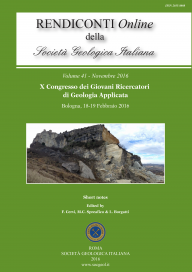
Spatial modeling of ash-fall pyroclastic deposits for the assessment of rainfall thresholds triggering debris flows in the Sarno and Lattari mountains (Campania, southern Italy)
Rita Tufano (a), Francesco Fusco (a) & Pantaleone De Vita (a)
(a) Dipartimento di Scienze della Terra, dell'Ambiente e delle Risorse (DiSTAR) – University of Naples Federico II, Via Mezzocannone, 8, 80134, Naples, Italy. E-mail: ritatufano89@gmail.com
Volume: 41/2016
Pages: 210-213
Abstract
Among the mountain ranges that surround the Somma-Vesuvius volcano (southern Italy), the Sarno and Lattari mounts are the closest and those where the highest thicknesses of ash-fall pyroclastic soils were deposited. Therefore, pyroclastic soil mantled slopes along these physiographic units are the most affected by rainfall-induced debris flows that, in these areas, represent one of the major geohazards of Italy. According to their strong societal impact, many studies were focused on the assessment of early warning systems based on the analysis of hydrological forcing that trigger debris flows. In this research, an attempt to consider the effect of spatial variability of ash-fall pyroclastic soil deposits and the related stratigraphic settings was carried out to assess rainfall conditions leading to initial slope instabilities that trigger debris flows. A key point was to model the spatial distribution of ash-fall pyroclastic deposits by considering the orientation of the dispersion axes of the main Plinian eruptions, the distance from the eruptive centre and the slope angle. The resulted conceptual geomorphological models, reconstructed for both the considered mountain ranges, were used to simulate hydrological processes that determine initial slope instabilities and to assess the related rainfall thresholds, taking also into account antecedent conditions.
Keywords
ash-fall pyroclastic deposits, stratigraphic setting, debris flows, hillslope hydrological processes.
Get Full Text